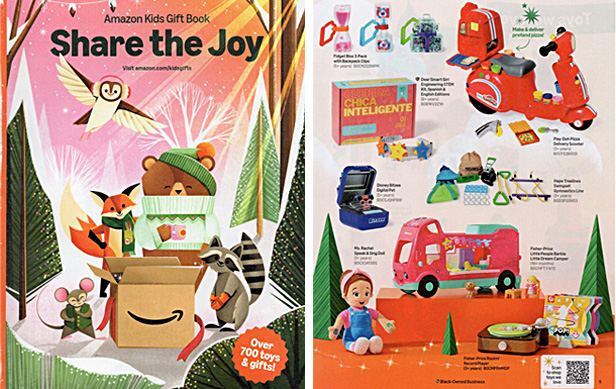Strategy October 21, 2024
The Triumphant Return of Physical Catalogs
Retailers like Amazon and J.Crew have scored big with their printed catalogs, proving this storied marketing medium is more than just a nostalgia play.
The hottest holiday toy catalog has hit the mailboxes of customers around the country, filled with hundreds of goodies and an illustrated cover designed to appeal to wide-eyed kiddos eager for toys.
The outfit behind this breakout piece of print marketing? Amazon – the company that ushered in the e-commerce revolution.
It might seem odd that the largest online retailer in the world is spending ad dollars on a decidedly non-online campaign ahead of the holidays. But Amazon is just one of several retailers old and new who are leaning into print catalogs. Retail brand J.Crew announced the return of its iconic catalog last month to the joy of fans around the country. Sustainability giant Patagonia’s catalog has evolved into something resembling a “journal,” the company says, selling the story of the products more than the products themselves. Even companies who have stalled on catalogs have pushed print in other ways – IKEA printed its last catalog in 2020 but launched a zine titled Catalogue!!! at Milan Design Week.
What’s old is almost always new again – and print catalogs are indeed coming back around.

Amazon started sending out toy catalogs when Toys “R” Us stores closed down in 2018, using the non-digital format to capture a new market segment. (Photos courtesy of Amazon.)
Why Print?
As advertising has transitioned more and more online during the last decade, many catalogs have moved to digital formats as well. But the print mediums that do remain can hold more weight, J.Crew Men’s Creative Director Brendon Babenzien told Esquire. “The catalog is this physical thing that really gives a little more gravity to the images and the clothes,” Babenzien said. “And the timing is really good, essentially, because we do live in the digital age.”
For many people, catalogs evoke a certain nostalgia – circling all the toys in the Sears catalog ahead of the holiday season, or accumulating stacks of Pottery Barn mailers on the kitchen counter. And marketing that relies on those feelings has real power. A product or marketing campaign that brings out fond memories creates a positive link with the associated brand – and a study from social media analytics firm Sprout found that 57% of consumers are more likely to increase spending with a brand if they feel connected to it.
J.Crew’s catalog relaunch – and the company’s entire comeback since it declared bankruptcy in 2020 – capitalizes on just that.
Before it was discontinued, the J.Crew catalog was among the most iconic in American fashion. With a reboot that heavily leans into that heritage, the retailer is on pace for a reported $3 billion in revenue this year.
“We’re finally back in the driver’s seat,” Libby Wadle, J.Crew’s CEO, told the Wall Street Journal. “We were seeing many generations come back into the brand or join the brand for the first time.”
And it’s not just warm, fuzzy feelings that can make catalogs effective.
A Harvard Business Review study sent out catalogs to thousands of U.S. customers with one e-commerce retailer. They found that those who received both physical catalogs and email marketing purchased 24% more than those who just received emails – and the ROI for catalogs was even higher for customers categorized as “physical-prone,” meaning that they made most of their purchases in-store.
Particularly for those who favor a non-digital approach, then, catalogs can make a powerful impact.

ASI’s Storied History With Catalogs
ASI’s catalog collection has been a key part of its promo industry offerings for decades. The Consolidated Catalog, one of the promo industry’s first catalogs, debuted in 1956 to let distributors shop all available supplier products before platforms like ESP made that easy. A version of that catalog is still around today in ASI’s annual Gift Book, as well as the twice-yearly Idea Showcases, one in the spring and one in the fall, and the annual Spectrum catalog.
Catalogs in the Industry
Much like the rest of the advertising industry, promo businesses have also moved away from physical catalogs, migrating to online ordering platforms and digital lookbooks.
Especially as sustainability has become more important than ever, printing thousands of promo products catalogs that might just end up in the trash can wasn’t the best approach, says Mandi Rudd, director of new markets for Counselor Top 40 distributor Genumark (asi/204588). However, the ability to print on recycled paper and use safe inks is much more readily available now.
Printing regular catalogs also isn’t feasible for everyone in the industry. Counselor Top 40 supplier Hit Promotional Products (asi/61125), for example, adds and removes products every week, says David Walker, the supplier’s vice president of sales – any printed catalog would likely become obsolete quickly.
“At this point, for somebody of our size, it just doesn’t make sense,” Walker says.
Still, while clients haven’t been dying for a mailbox full of physical catalogs, they’re still around in promo; many suppliers continue printings to hand out at industry trade shows or sales meetings.
When most suppliers still mailed out catalogs, Rudd often used them for idea generation – a way to be productive without being online.
“It’s almost like a moment of quiet in a lot of chaos,” says Laura Smith, director of product and sustainability at apparel supplier Storm Creek (asi/89879).
24%
How much more consumers who received both email marketing and a physical catalog purchased compared to consumers who just received email.
(Harvard Business Review)
If used strategically, a well-curated physical catalog could provide promo firms with a way to capitalize on nostalgia marketing and appeal to a new audience demographic. In that case, quality and maximizing space is key, says Smith.
Storm Creek, a Counselor 2024 Best Place to Work, produces one annual catalog that’s intended to guide clients all year, and Smith says the supplier’s focus is on optimizing each page in the book to have the most impact with the least space.
And, she adds, many customers have told her they do appreciate having something physical on their desks to look at.
“We really put a lot of energy and time and effort into making one book for the year that then becomes not so much a disposable piece as it is a reference piece to have on hand all the time,” Smith says.

Storm Creek (asi/89879) produces an annual catalog that’s meant to be a year-long reference guide for distributors.
The supplier is also intentional about who to send catalogs out to, Smith says. It’s not a random list of potential buyers that just “might” purchase – it’s focused on clients who Storm Creek knows are going to want the physical version.
Pam Preuss, marketing manager at Charles River Apparel (asi/44620), says the supplier mails some catalogs, but they’re also commonly used at sales meetings so clients can handwrite notes. They also typically leave behind a copy or two of their catalogs for long-term reference.
“When they’re in that meeting,” Preuss says, “and the sales rep is providing them additional information outside of what’s in that printed catalog – if it sparks something in their head that could help them sell, they might jot that down.”

Three Strategies To Take Advantage of the Catalog Revival
1. Curate Your Recipient List
Not everyone will want a physical catalog, but it could make a big sales difference if your audience is appropriately curated. Amazon, for example, only sends its toy catalog to select consumers – likely ones who have ordered kids products or toys in the past.
Do you have clients that always take pen-and-paper notes? Does one of your biggest customers keep a stack of reference books on their desk for inspiration? Is there a distributor who always places orders at trade shows after they hear more about a product from you directly? These all could be candidates for a fun catalog campaign.
2. Incorporate Technology
While catalogs aid sales and marketing, they’re clearly not the main way people are placing orders – and retailers know this. Both Amazon’s holiday catalog and the relaunched J.Crew fall catalog feature QR codes alongside product listings to direct shoppers to the retailers’ respective sites for ordering, which could be a particularly smart design choice for promo suppliers that stock thousands of individual items.
3. Tell Your Clients a Story
Take a leaf out of sustainability giant Patagonia’s book and use your catalog to not only showcase your new products but tell your clients the story behind them – and the people that use them. Catalogs designed with a mix of photos and short narratives about the products being showcased are 40% more effective in sales and customer engagement than designs with just photos and product names, according to a Harvard Business Review study.
